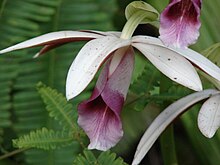Phaius tankervilleae
| Swamp orchid | |
|---|---|
 |
|
| Scientific classification | |
| Kingdom: | Plantae |
| (unranked): | Angiosperms |
| (unranked): | Monocots |
| Order: | Asparagales |
| Family: | Orchidaceae |
| Subfamily: | Epidendroideae |
| Tribe: | Collabieae |
| Alliance: | Calanthe |
| Genus: | Phaius |
| Species: | P. tancarvilleae |
| Binomial name | |
|
Phaius tancarvilleae (L'Her.) Blume |
|
| Synonyms | |
|
|
Phaius tancarvilleae is a species of orchid widespread in the Indian Subcontinent, New Guinea, China, Japan, Southeast Asia, Indonesia, Malaysia, the Philippines, Australia and certain islands of the Pacific. It is also naturalised in Hawaii, Panama, the West Indies and the US State of Florida
In Australia it is found as far south as Yamba, New South Wales and further north in tropical Queensland. It is listed as endangered with possible extinction within the country.
Common names include greater swamp-orchid, swamp lily, swamp orchid,nun's-hood orchid,nun's orchid and veiled orchid.
In 1778, John Fothergill brought this orchid back from China to England. Later, Joseph Banks named the plant in honour of Lady Emma Tankerville, as the orchid flowered in her greenhouse at Walton-on-Thames near London. The species name refers to the origin of the married name of Emma, the Countess Tankerville. That being the town of Tancarville, in Normandy, France.
...
Wikipedia

